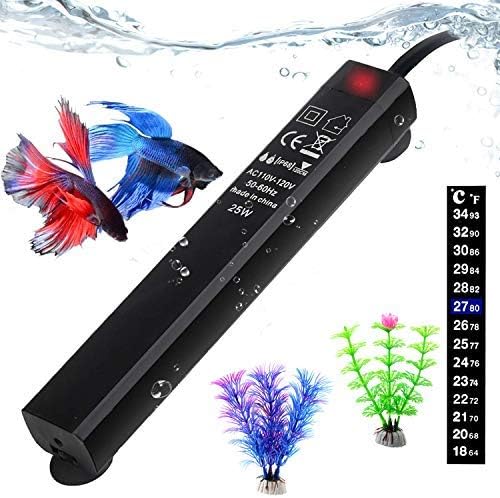The temperature of the fish tank is important for the well-being of the species of fish inhabiting it. Unlike human beings and warm-blooded pets, species of fish tend not to generate their unique physique heat. They have to think about the temperature of the water to manage their internal temperature. The fish tank water heater information below covers everything you wish to understand relating to heating units and can cover types of fish tank heaters, sizes, and placement of the heater.
Deciding on the sort of fish tank heater to use along with your fish tank is not difficult as long as you recognize the variances between a variety of aquarium heaters. There are a variety of basic fish tank heating units: immersible heating units, submersible heating units, substrate heating units, and filtration system heating units. Depending on the size of your tank and extra components like a sump, you’ll have to decide what’s going to work best for your fish tank.
Figuring out which sort of tank to acquire for your fish tank is simply the most picturesque. Heaters occur in many sizes and power ratings. Are you still undecided as to what actual size tank you wish for your fish tank? There is a way to research the right size tank using the size of your tank and the desired temperature. Once you recognize what size heater you wish and also the type of heater, you’re able to choose the complete. Please read reviews online or on the fish tank heater website at the end of the article to see what heaters are worth buying.
Numerous species of fish that need warmed-up water for ideal health and fitness (such as the Betta) are held in small tanks or containers. Regrettably, mini tanks and smaller types of fish tanks may well be a difficult task to heat adequately. In the past couple of years, perhaps, a range of small heating units were introduced to the fish tank market. Have a look at these styles of heating units specifically created for mini aquariums if you own a tank that is 10 gallons in volume. They’re typically marketed as “nano” or “pico” heaters and get the job done fairly well while not overheating the tank with a full-sized aquarium heater.
Once you buy a fish tank heater, the next step is deciding where to position it in the tank. Should the item be settled in the middle or off to one side? Are you able to route this very efficiently? Can it possibly make a difference? There are several simple, although crucial, tips for correct tank placement. A bit of trial and error also goes a long way. You’ll need to take a position during a thermometer probe to accurately monitor the fish tank temperature.
Even under great conditions, problems will occur. The most frequent undesired event is typically a tank that decides to break without warning. If you are simply worried about this happening, you want to consider utilizing a tank safeguard. You’ll want} to have it when you need it. You might as well throw it in the cart when you buy the heater.
Another difficult fish tank heater task is typical during the summertime when fish tank water temperatures increase along with the ambient temperature. At times, turning off the aquarium heater is not enough to prevent hazardous excessive water temperatures, and extra measures are required to keep the species of fish cool. One will add cups of cold water, but that’s quite long. Chillers exist and are the opposite of the heater. If you are roughly in the middle hemisphere, you might as well throw a chiller in the cart along with your fish heater and heater safeguard.
In the wintertime, the opposite issue will occur. This is often very true should your water heater not be able to provide enough heat during the wintertime of the year, and measures should be taken to keep the species of fish warm. Either a stronger heater or, ideally, a second heater should be considered. Two heaters can make sure the tank does not get too out of line should one fail. Though your 300-watt heater is twice as strong as a 150-watt heater, should it decide not to turn on, then it becomes a 0-watt heater. might as well throw a second heater in the cart.
Hopefully, after reading this, you’ll have an improved plan for what type of fish tank heater to get. Once you’ve got a perfect system in place, you will not have to worry because you know the fish tank temperature is going to be constant, and if one thing were to fail, there are safeguards in place to stop the disaster.




